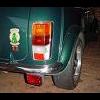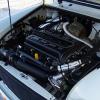Hi there, I really do understand your feelings about trying to fix this, And I am sorry that all I can offer is suggestions to the probable cause, I myself am still learning

With a little more thought on this, if this hesitation/ flat spot is a very short period after depressing the accelerator, this may indicate a problem with throttle position sensor. This sensor tells the ECU the rate of throttle opening. The ECU can then decide how much extra fuel to inject to compensate for a transient,'lean' condition.
Explanation of transient fueling (acceleration enrichment)
Baisicaly, the fueling is a closed loop control. The ECU injects a fuel amount based on the pre programed maps. this fuel then has to travel from the injector, past the throttle, down the inlet manifold, past the valves into the combustion chamber, where it is then burnt, and the waste gasses exit through the exhaust where it passes over the Lambda sensor, where the oxygen content is sensed, this signal is then fed into the ECU and calculates any correction tothe base map fueling.
All that takes time, something like half a second. Obviously the slower the air entering the engine at low engine speeds the longer this time will be, and the faster the air entering the engine at higher engine speeds, the shorter this time will be.
Wheres this going I hear you say. When you accelerate, there is a 'transient' lean condition as more air enters the engine with very little change in fueling. Without the addition of extra fuel the engine will hesitate, untill the ECU receives the feed back from the Lambda sensor to say that it is lean and then it would recover. To prevent this condition the ECU monitors the Throttle Position Sensor for the rate of change and adds a predetermined amount of extra fuel in relation to the rate. This prevents a transient lean condition and the engine runs without hesitation.
If the TPS is not working correctly, the ECU may not be adding transient fueling causing the engine to hesitate momentaraly
There, a little long winded, lol, but then I have always been

Just thought you would be interested to know how the ECU controls the transient fueling so you could possibly understand your problem a little more.
The TPS is the same as used on many of the Rover cars of around the same age, The Rover 100, or Kensington 1.1 would be your best bet as they were all single point. Dont know if these cars are that common in Oz

If you find it difficult getting hold of a TPS, flirt me over your Address on PM, and I'll send one out to you, I'll only ask the cost of postage

Worth elliminating this before you go to the expense of sending the ECU off for testing, its rarely the ECU, but they do occasionaly fail.
Again a diagnostic code reader would be able to show you the TPS volts or perceent, but its down to the user to determine if it is correct or not, not the code reader throwing up a fault. Same goes for the sensors

Would it not be worth your while trying to get hold of one of these code readers from the UK Ebay. You could maybe then earn your money back helping others maybe in a similar predicamant, all be it having to post it out on an exchange basis?? Just a thought


Sprox
















